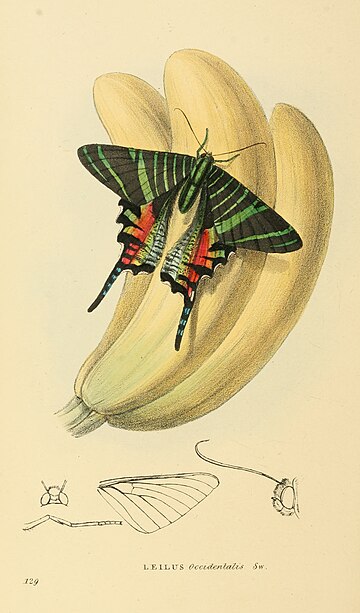Zoological Illustrations Series II/Plate 129
LEILUS Occidentalis. Sw.
LEILUS Occidentalis,
West India Emerald-Butterfly.
Specific Character.
Posterior wings with a flame-coloured, irregularly indented, marginal band; tails black, with emerald green spots.
Papilio Sloaneus. Cramer. pl. 85. e. f. vol. 1. p. 134.
Papilio Leilus. var. Fab. Ent. Syst. 3. 1. 22.
Specimens of this rare and splendid species, sent to our museum from the island of Jamaica, enable us to complete the illustration of the only three American species of this type hitherto discovered. It is in all probability the same as that figured by Cramer; particularly as his specimens came from the same locality. Even a superficial comparison of this figure with those on our two last plates, will shew the error of Fabricius and others, in classing them all under the same name. We have represented the species in that attitude which is assumed by L. Braziliensis, when at rest; the wings of which species are sometimes less but never more expanded: the fruit, upon which the insect is reposing, is the common West India Banana, shewing its natural size.
In drawing the attention of Entomologists to the anatomical details of this typical example of the genus Leilus, it will be readily perceived that the obscurity which has involved its natural affinities, has entirely arisen from ignorance of its structure. At a time when minute and obscure Coleoptera are submitted to the most delicate dissection, under powerful magnifiers, the Lepidoptera, not only the most striking and splendid of all insects, but the pre-eminent type of the Annulosa, have been comparatively neglected. We cannot otherwise account for this, but by remembering that the influence of fashion is universal, and that she is always followed by the majority. This exclusive devotion however, to one order, is highly detrimental to the study of the natural system; or with so many profound Entomologists who have gone before us, it would not have been left for us to make known the fact, that the sub-family Papilionæ, represents the sub-family Harpalinæ, (Harpalidæ, Auct.) And that this analogy is not only demonstrable by the peculiar construction of their tibiæ, but by the parallel relations and by the circular affinities of the Coleoptera and the Lepidoptera.
